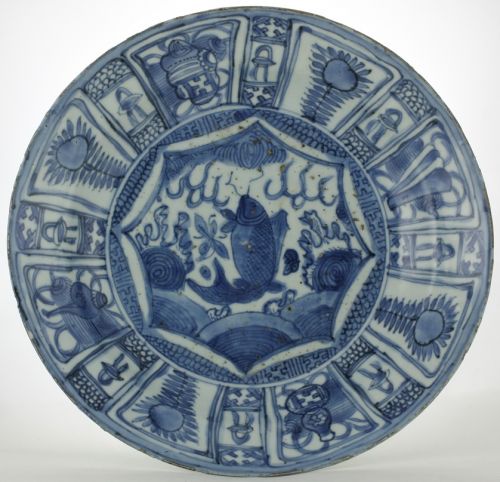
Sold Ceramics - Sold Kraak Porcelain wares 1570-1645 - Dishes - Page 2
Object 2011068
Dish
China
1630-1650
Height 50 mm (1.97 inch), diameter of rim 275 mm (10.83 inch), diameter of footring 252 mm (9.92 inch)
Dish on footring, slightly scalloped flat rim. Decorated in underglaze blue with a cat fish (nien ju), which is identified by its barbells, it is depicted here among crested waves and flames, encircled by an eight pointed scalloped medallion. On the sides and rim large panels filled with peach and auspicious symbols alternating with narrow panels with a diaper or scale pattern and tassels. The scheme of the underside repeats that of the front, large ogival or round panels filled with fungus and dots alternating with narrow panels with lingzhi motifs
According to Rinaldi this dish can be classified as a Border VII.3 dish. Borders in this group show a great variety in their decorative motifs. The most common bears the sunflower motif alternating with large and simply drawn symbols. Dishes with similar border were found among the shards from the Portuguese São Gonçalo shipwreck (1630) in Plettenberg Bay, South Africa. (Rinaldi 1989, pp.106-108)
The reproductive powers of the fish may also explain its popularity as a peasant motif, while the jumping element is indicative of academic success. This is due to the story about the fish which swim up the Yellow river every year, and which on their way must leap up the Dragon Gate Falls. Those that succeed in passing above the rapids are transformed into dragons. (Kerr 1986, p.79) Fish are among the earliest known subjects on Chinese ceramics appearing in the Neolithic period of the fifth to fourth millennium BC. Fish are rich in symbolic meanings. Because of the phonetic similarity between the word yu, meaning fish, and yu, meaning abundance, images of fish in Chine came to be considered emblematic of wealth and prosperity. The reproductive power of fish is regarded as a symbol of regeneration and fecundity. And because fish are thought to swim in pairs, they are reputed to be the emblem of the joys of union, particularly of the sexual kind. (Ströber 2011, p.102) The fish is a symbol of wealth and abundance. Although different species of fish are found on kraak dishes, it is overall a very rare motif.
For similarly decorated dishes, please see:
- Fine and Important Late Ming and Transitional Porcelain, recently recovered from an Asian vessel in the South China Sea. The Property of Captain Michael Hatcher. Auction catalogue Christie’s Amsterdam, 12 and 13 June 1984, pp.16-17, lot 137.
- The Wanli Shipwreck and its ceramic cargo, (S. Sjostrand & S. Lok Lok bt. Syed Idrus, Ministry of Culture Arts and Heritage, Malaysia, 2007), pp.190-191, Serial No. 2566.
Condition: One tiny firing hairline and two tiny, firing, glaze hairlines, a chip and some shallow unglazed rough spots all to the rim. Some frits and chips to the footring.
References:
Sjostrand & Lok Lok 2007, Serial No. 2666, Serial no. 4136C, 4542A, 5095, 5096 and 5097A
Price: Sold.


 create websites
create websites